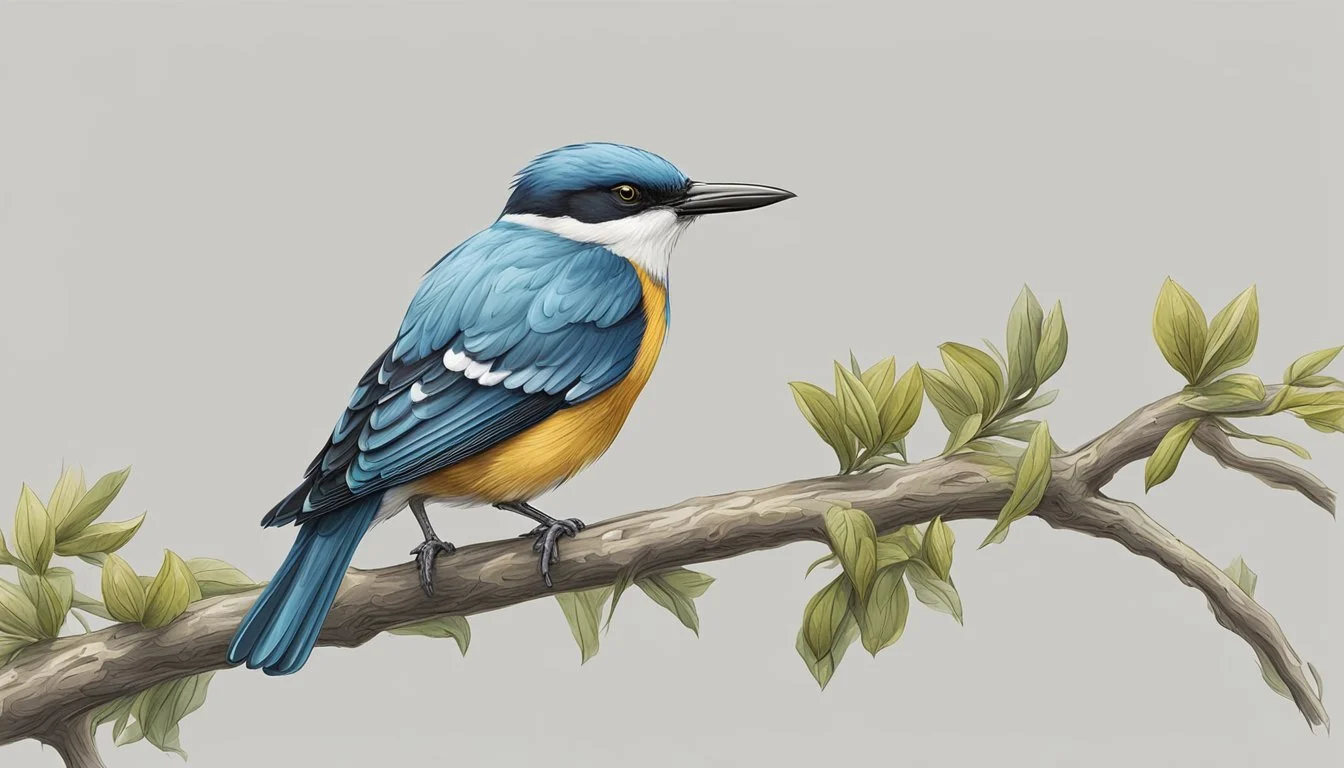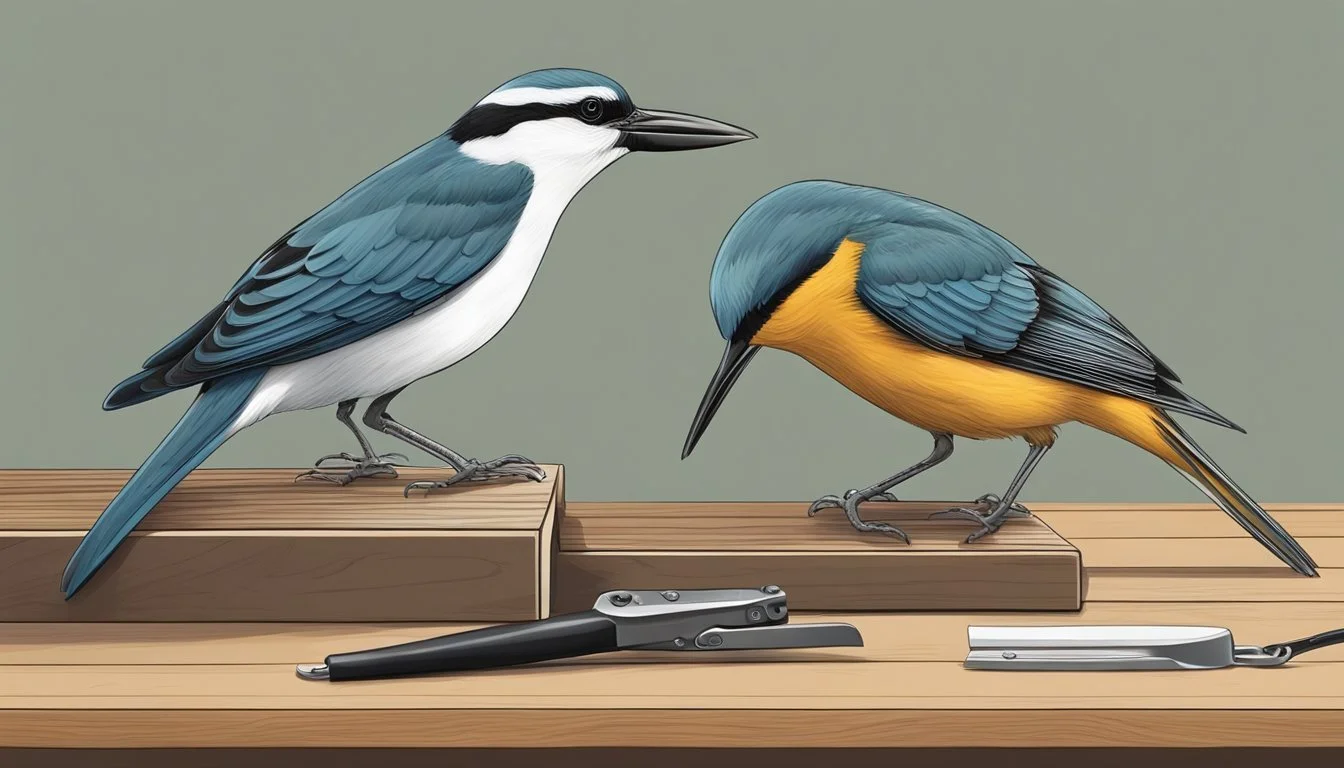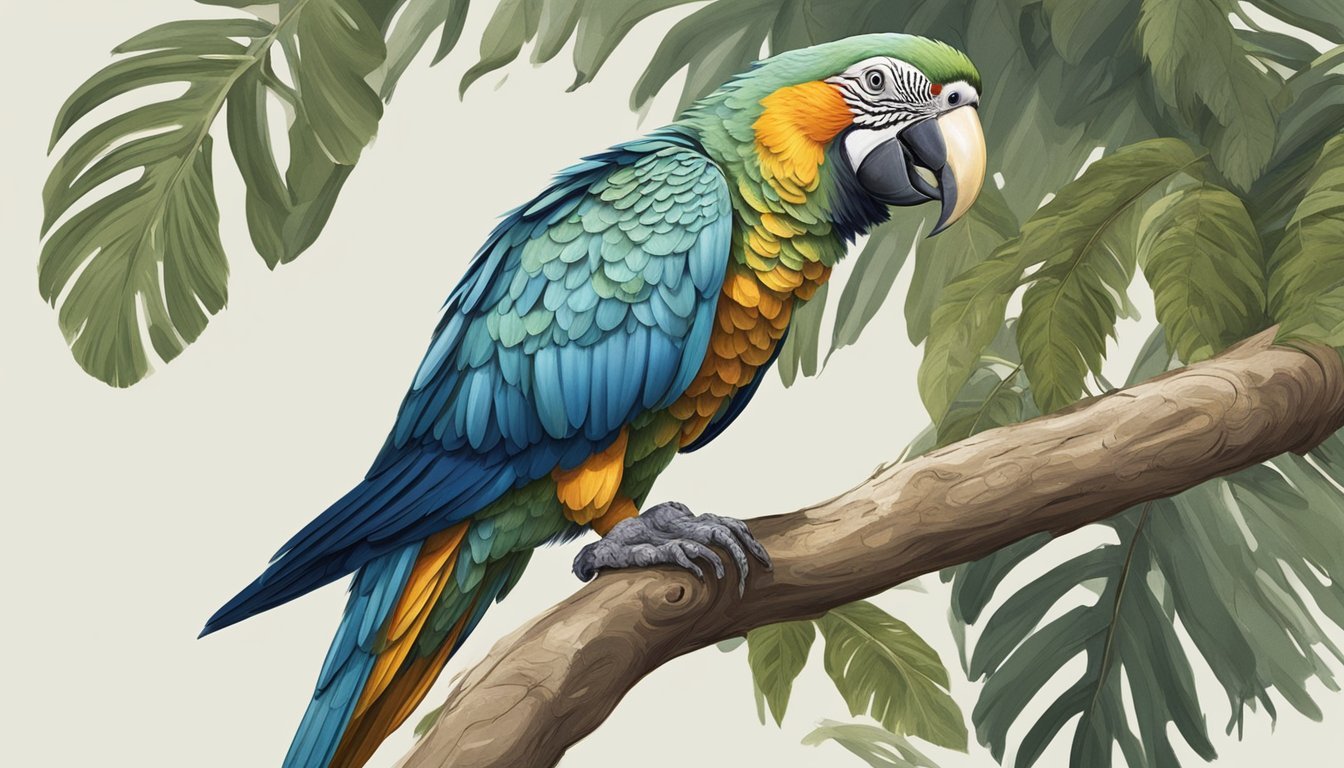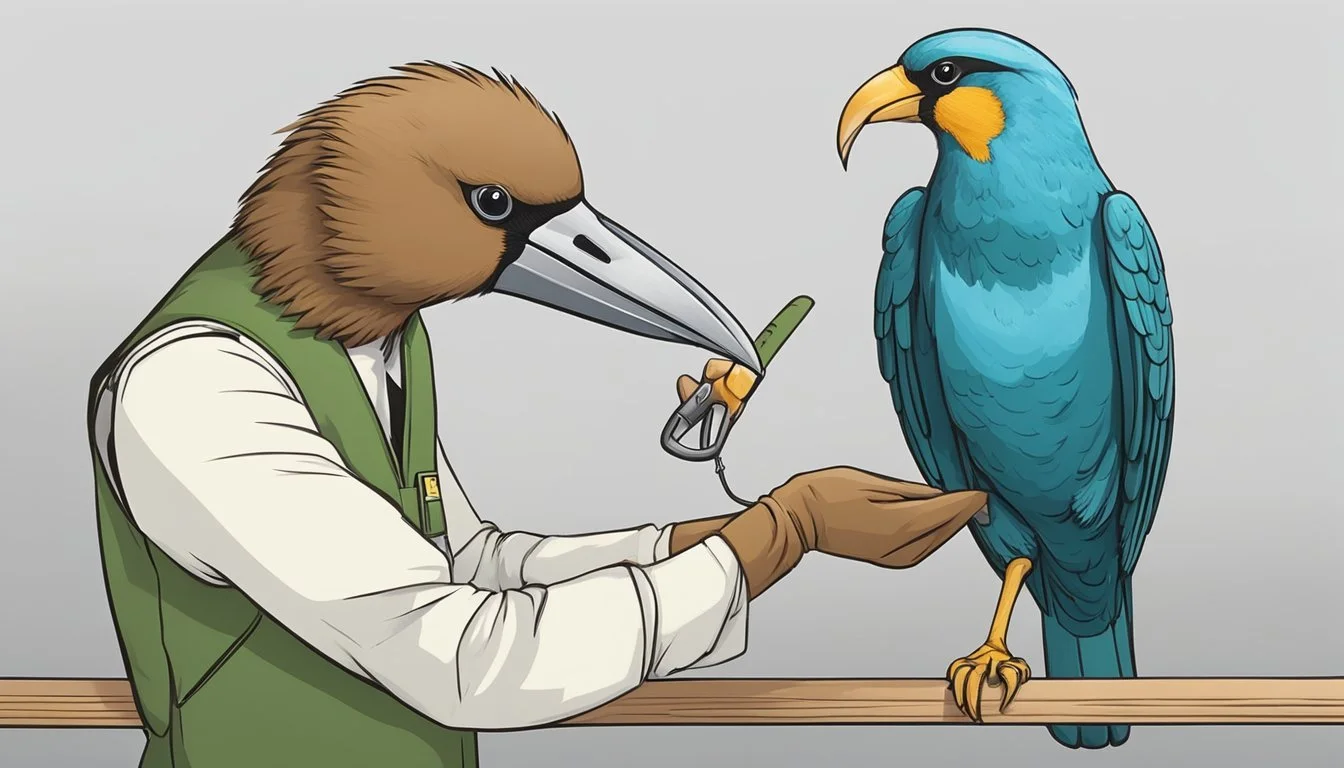How do I ensure proper beak and claw care for healthy pet birds?
Proper beak and claw care is essential for the health and well-being of pet birds. A well-maintained beak is crucial for birds, as it not only serves as their primary tool for handling food, but also as a means of interaction and communication with their environment. Similarly, healthy claws are necessary for good footing and mobility, preventing overgrowth that can lead to discomfort or injury. Bird owners must pay close attention to their pets' beak and claw condition to ensure they can carry out their daily activities comfortably and effectively.
The process of beak and claw maintenance includes periodic trimming and providing opportunities for natural wear and tear. Trimming should be done with caution to avoid injuring the quick, the vascular part within the beak and claws that can cause pain and bleeding if cut. A bird's diet and environment also play significant roles in the health of its beak and claws. Offering a well-balanced diet can promote strong beak and nail growth, while a variety of perches with different textures encourages natural abrasion that helps keep a bird's claws at a proper length.
Bird owners should regularly inspect their pet's beak and claws for any signs of irregularities, such as cracks, overgrowth, or abnormal shapes. Observing the bird's behavior is also important, as difficulty in perching or handling food might indicate an underlying issue with their beak or claws. In addition to home care, professional consultations with an avian veterinarian are recommended to address any concerns and to provide guidance on proper beak and claw care practices.
Understanding Beak and Claw Anatomy
Proper care of a bird's beak and claws is an essential aspect of avian health. Both structures are made of keratin, the same protein that forms human nails and hair, and require regular maintenance to function optimally.
Keratin Growth and Structure
Bird beaks and claws are primarily composed of keratin, a durable and flexible protein that grows continuously. The beak is an extension of the skull with a sheath of keratin covering the bone underneath. Similarly, claws are keratinous coverings over the bone at the tips of a bird's toes. They are anchored securely in the skin and must be kept at the proper length and shape to ensure the bird's overall agility and ability to grasp or manipulate objects.
Beak and Claw Functions
The beak is a multifaceted tool serving various functions, from feeding to nest-building to grooming. Its shape and size are directly related to the bird's diet and habitat, with variations that range from the strong, nut-cracking beak of a macaw to the slender, nectar-sipping form of a hummingbird. On the other hand, claws are critical for perching, climbing, defense, and sometimes food handling, contingent on the bird species. It is vital for these structures to maintain their integrity, as they play a direct role in a bird's ability to survive and interact with its environment.
The Importance of Beak and Claw Health
Proper care of a bird's beak and claws is crucial for their health and ability to perform daily activities. A well-maintained beak and claws contribute significantly to a bird's balance and overall well-being.
Preventing Injuries
Injuries to the beak or claws can lead to serious health issues. Regular maintenance helps prevent accidents that can occur during regular activities, such as climbing or foraging. Inspecting and caring for these parts reduces the risk of deformities and ensures that any injuries are treated promptly, minimizing the impact on the bird's health. Providing a clean and safe environment can also ward off potential hazards that may cause harm.
Promoting Overall Well-being
The state of a bird's beak and claws is indicative of their overall well-being. Birds use their beaks not only for eating but also for grooming, manipulating objects, and social interactions. Similarly, their claws are essential for grasping surfaces, which affects their balance and mobility. Furthermore, beak and claw health can reflect the nutritional status; a balanced diet is key to maintaining healthy growth and condition.
Role in Eating and Activities
For a bird, the beak is a primary tool for eating. Any issue with the beak can interfere with their ability to access or consume food, potentially leading to malnutrition. Claws are vital for climbing and securing food, and overgrown or poor claws can inhibit these activities. Therefore, it is important to monitor beak and claw condition to ensure that birds can effectively feed themselves and engage in their natural behaviors, contributing to a healthy lifestyle.
Routine Maintenance and Grooming
Proper maintenance and grooming are essential to prevent issues such as overgrown beaks and claws, which can affect an animal's ability to eat and move comfortably. A regular inspection and cleaning regimen will ensure that any overgrowth is dealt with before becoming problematic.
Regular Inspection
Regular inspections are crucial in identifying early signs of overgrowth in beaks and claws. One should inspect the beak and claws weekly for any noticeable changes in length, shape, or texture. Signs of poor health, such as discoloration or cracks, also warrant attention to prevent future complications.
Trimming Techniques
Trimming is a delicate process that requires both knowledge of the correct technique and the use of the appropriate tools. It is important to:
Identify the quick, which is the blood supply to the beak or claw, to avoid painful injury.
Utilize sharp and sterile trimming tools to ensure a clean cut.
Trim gradually, in small increments, to prevent overcutting.
Do: Trim in good lighting
Don't: Rush the trimming process
Do: Restrain the animal gently
Don't: Cut into the quick
Do: Reward the animal post-trimming
Don't: Use blunt or unclean tools
Dealing with Overgrowth Issues
When dealing with an overgrown beak or claws, professional intervention from a veterinarian or an experienced groomer is often necessary. Overgrown beaks may cause difficulty in eating, and overgrown claws can lead to mobility issues or discomfort. In such cases, they will consider the animal's health and provide a proper grooming schedule that includes:
Frequent trimming to gradually return the beak or claws to a comfortable and functional length.
Environmental enrichment to encourage natural grooming behaviors.
Dietary assessment to ensure nutrition is not contributing to overgrowth.
Choosing the Right Tools
When it comes to avian grooming, selecting the appropriate tools is a critical step to ensure the health and comfort of your bird. Accurate and efficient beak and claw care requires the use of specific tools designed for these delicate tasks.
Beak Trimming Tools
Bird Nail Clippers or Dremel: For beak trimming, one should use either specialized bird nail clippers or a Dremel tool with a sanding attachment. The clippers should be sharp to make clean cuts without causing splintering or unnecessary pressure on the beak.
Styptic Powder or Cornstarch: It's important to keep styptic powder or cornstarch on hand to quickly stop bleeding in case of any accidental nicks.
Learn how to safely trim your Cockatoo's beak.
Claw Care Implements
Emery Board or Filing Stone: Maintaining claw length and sharpness can be achieved through the use of an emery board or filing stone. Regular filing can prevent a bird's claws from becoming overgrown or sharp, which can lead to accidental injury.
Nail Clippers: Alongside an emery board, nail clippers designed for birds can be used to trim the claws before filing. They must be the appropriate size for the bird to ensure safe and precise cuts.
Discover tips for successful beak and claw maintenance.
How to Safely Trim Beaks and Claws
To maintain your chickens' well-being, it's important to perform beak and claw trimming with care. This prevents overgrowth that can lead to health issues or feeding problems. The process involves identifying sensitive areas, handling the bird properly, and minimizing their stress.
Identifying the Quick
The quick is the blood vessel and nerve within the beak and claws. It's essential to locate this before trimming to avoid pain and bleeding. In beaks, look for a change in coloration to understand where the keratinized part ends and the quick begins. As for claws, transparency often aids in detecting the quick's pinkish hue. If the quick is cut, it can cause significant stress and pain.
Proper Handling Techniques
Secure handling is critical for the safety of both the chicken and the trimmer. Wrapping the chicken in a towel can prevent sudden movements and reduce stress. Hold the chicken's head gently but firmly to perform a beak trim. When trimming nails, secure the toe between your thumb and forefinger. Quick actions and calm behavior contribute to a stress-free experience.
Avoiding Stress and Pain
Beak trimming and cutting nails should be done with precision tools and with the goal of avoiding stress and pain. Make small cuts to gradually reduce the length and avoid the quick. If bleeding occurs, have styptic powder or cornstarch handy to stop it promptly. Aftercare involves monitoring the chicken to ensure there is no prolonged discomfort or infection.
Professional Care
Ensuring proper beak and claw care for birds requires attention to detail and expertise. Professional care from an avian veterinarian is paramount to prevent complications such as infections and to maintain the overall well-being of the bird.
When to Visit an Avian Veterinarian
Bird owners should schedule regular check-ups with an avian veterinarian. It's critical to seek professional care if there are signs of abnormalities or behavioral changes that could indicate discomfort or disease. Examples include beak misalignment, overgrown claws, or difficulty perching. Moreover, an avian vet is essential if any signs of infections are present, as they require specialized treatment.
Understanding Veterinary Beak and Claw Services
The range of services provided by an avian veterinarian encompass routine trimming as well as corrective procedures for beak and claw deformities. They use sterilized equipment to ensure the safety and well-being of the bird during these procedures. For beak care, avian veterinarians expertly trim overgrowth and correct deviations, taking care not to cut too close to the quick which could cause bleeding or pain. In the case of claws, trimming is done with precision to maintain optimal length and shape for healthy perching and movement.
It is crucial to trust these delicate tasks to a qualified professional who understands the particular needs and anatomy of avian species.
Diet and Environmental Factors
Maintaining the health of a bird's beak and claws requires attention to both their diet and the environments in which they live. These factors play a critical role in promoting overall well-being.
Hygienic Perching Surfaces
Birds inevitably spend a considerable amount of time on their perches, making hygiene of these surfaces paramount. Regular cleaning prevents the build-up of harmful bacteria that can affect beak and claw health. Wooden perches are beneficial as they mimic a bird's natural habitat and help in naturally wearing down the claws.
Dietary Influences on Beak and Claw Health
A balanced diet is essential for healthy beak and claw growth. Birds require a mix of vitamins and minerals; particularly, calcium and vitamin D3 are critical for strong beak and bone development. Fresh vegetables should be a staple in their diet, as they offer essential nutrients. For instance, dark leafy greens are an excellent choice for promoting robust health.
Enrichment and Exercise
Enrichment activities encourage birds to engage in behaviors that naturally wear down their beaks and claws. It not only stimulates their minds but also ensures they get ample exercise, which is vital for their physical health. Making use of textured natural materials can provide opportunities for birds to chew and grip, both promoting proper beak and claw wear.
Recognizing and Addressing Abnormalities
Proper beak and claw care in birds is essential to their overall health. Identifying and treating abnormalities early can prevent further complications.
Signs of Beak and Claw Disorders
Abnormalities in a bird's beak or claws can manifest as overgrowth, cracks, or injuries. Signs of beak disorders may include misalignment or unusual shapes that hinder eating or speech in species capable of mimicry. For claws, watch for excessive length or brittleness. Liver disease may also contribute to beak and claw problems, as it can lead to overgrowth and deformities. Changes in color or texture, such as a flaky or rough beak surface, can indicate a bacterial or fungal infection.
Treatment and Recovery
For beak abnormalities caused by trauma, bacterial infections, or nutritional issues, a veterinarian may recommend a diet change supplemented by vitamins or medication. In cases of mild trauma or infection, healing is often possible with proper care and treatment. Severe injuries may require surgical intervention or specialized beak trimming. Claw issues primarily caused by surface injuries often respond well to topical treatments and a clean, safe environment to prevent infection. However, if abnormalities are due to underlying health conditions like liver disease, comprehensive treatment addressing the primary illness is necessary. Recovery from these conditions requires diligent care and monitoring by the bird's caretaker and a qualified avian veterinarian.
Beak and Claw Care in Specific Bird Populations
Proper beak and claw care is essential for birds' health and varies significantly across different bird populations. Specific care routines are determined by factors such as age, living environment, and species characteristics.
Special Considerations for Chicks
Chicks require gentle care for their developing beaks and claws. A diet rich in nutrients is fundamental for healthy growth. Breeders may need to monitor chicks for signs of deformities or growth issues, as these can indicate the need for diet adjustments or veterinary intervention. For example, finch chicks may need a high-protein diet to ensure proper beak development.
Older Birds and Special Needs
Older birds often face challenges like beak overgrowth and claw thickening. Regular trimming might be necessary as their ability to naturally wear down their beak and claws declines. Birds with special needs, perhaps due to a past injury or a congenital defect, might require custom care plans. Ensuring that these birds have access to specially designed perches can help maintain their beak and claw health without imposing undue stress.
Differences in Wild and Pet Bird Care
Wild birds typically maintain their beak and claws through natural behaviors, such as foraging and tree perching. In contrast, pet birds lack many natural opportunities for beak and claw maintenance and thus rely on their owners. Pet owners can mimic natural conditions by providing a variety of perches with different textures and materials. Additionally, wild bird conservation efforts may include providing clean water sources for beak maintenance, particularly in arid regions where birds like finches might struggle to find clean water for proper beak wiping behaviors.
Ethical Considerations and Practices
Proper beak and claw management practices in the poultry industry are not only integral for the health and productivity of the birds but also raise important ethical considerations. These practices, such as debeaking, can be contentious and require a balance between animal welfare and the operational needs of poultry farming.
Debeaking and Its Controversies
Debeaking, also known as beak trimming, is a common practice in the poultry industry to prevent cannibalism and reduce feed wastage. The procedure typically involves removing the tip of a chick's beak and is considered by some as a necessary management tool. Advocates maintain that this practice, when done correctly using proper equipment and at the appropriate age, ideally in young chicks, can minimize pain, excessive bleeding, and infection. However, opponents argue that debeaking can cause long-term pain and stress to the birds, thereby raising ethical concerns about the animal's welfare.
Welfare in the Poultry Industry
The welfare of chickens in the poultry industry is of utmost importance, and ethical husbandry practices are essential. Vaccination is one measure that has been widely adopted to promote the health of poultry flocks and prevent disease spread. Alongside this, finding alternatives to practices like debeaking is an ongoing conversation, with research into environmental enrichment and breeding for docility being potential ways to avoid the need for such interventions. The industry thus faces the challenge of implementing methods that enhance bird welfare while maintaining efficiency and profitability in operations. The American Veterinary Medical Association highlights that the decision to beak-trim should be made with consideration of each flock's circumstances and should not be undertaken lightly.
Being well-informed about the ethical practices in beak and claw management ensures responsible care for poultry while addressing the industry's concerns.
Emergency Situations and First Aid
In cases where a bird's beak or claws are injured, it is crucial to act swiftly and confidently. Handling such emergencies requires proper supplies and knowledge of pertinent first aid techniques to control bleeding and prevent further trauma.
Handling Bleeding Beaks and Claws
When a bird's beak or claw is bleeding, the first step is to remain calm and gently restrain the bird to prevent exacerbation of the injury. One can apply a small amount of corn starch or styptic powder directly to the bleeding area to help stop the bleed. Flour or cornstarch can serve as provisional alternatives if the other options are not immediately available.
Apply pressure using a clean cloth if bleeding continues.
In cases where bleeding does not cease or the injury seems severe, seek veterinary care immediately.
First Aid Supplies and Techniques
It is essential to maintain a well-stocked first aid kit for emergencies. Critical components for beak and claw care should include:
Styptic powder or alum, to quickly stop bleeding.
Corn starch, for those who prefer a more readily available hemostatic agent.
Sterile gauze and bandages to apply pressure or protect an injury post-application of a clotting agent.
Techniques for first aid include:
Applying styptic powder: Gently press the powder onto the cut surface for a few seconds.
Pressure application: Use a gauze pad if the bleeding does not stop with styptic powder.
Bandaging: Only to be done if instructed by a veterinarian, as improper bandaging can cause further harm.






